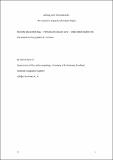Writing with twisted cords : the inscriptive capacity of Andean khipus
Abstract
Two newly discovered khipu (Andean twisted cord) epistles are presented as evidence that khipus could constitute an intelligible writing system, accessible to decipherment. Recent scholars have asserted that khipus were merely memory aides recording only numbers, despite Spanish witnesses who claimed that Inka era (1400 - 1532 CE) khipus encoded narratives and were sent as letters. In 2015, the author examined two khipus preserved by village authorities in Peru. Villagers state that these sacred khipus are narrative epistles about warfare. Analysis reveals that the khipus contain 95 different symbols, a quantity within the range of logosyllabic writing, and notably more symbols than in regional accounting khipus. A shared, mutually comprehensive communication system of such complexity presupposes a writing system, possibly logosyllabic. At the end of each khipu epistle, cord sequences of distinct colours, animal fibres and ply direction appear to represent lineage ("ayllu") names.
Citation
Hyland , S P 2017 , ' Writing with twisted cords : the inscriptive capacity of Andean khipus ' , Current Anthropology , vol. 58 , no. 3 , pp. 412-419 . https://doi.org/10.1086/691682
Publication
Current Anthropology
Status
Peer reviewed
ISSN
0011-3204Type
Journal article
Collections
Items in the St Andrews Research Repository are protected by copyright, with all rights reserved, unless otherwise indicated.

